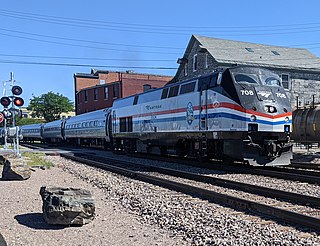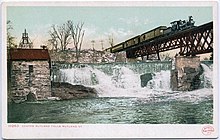
Manchester is a town in, and one of two shire towns of, Bennington County, Vermont. The population was 4,484 at the 2020 census.

The Ethan Allen Express is a daily passenger train operated by Amtrak in the United States between New York City and Burlington, Vermont, via Albany, New York. One daily round trip is operated on a 310-mile (500 km) north–south route with a 7-hour 35 minute scheduled running time. The train is subsidized by New York and Vermont for the portion north of Albany. It is named for Vermont cofounder and American Revolutionary War hero Ethan Allen.
The Central Vermont Railway was a railroad that operated in the U.S. states of Connecticut, Massachusetts, New Hampshire, New York, and Vermont, as well as the Canadian province of Quebec.

The Vermont Railway is a shortline railroad in Vermont and eastern New York, operating much of the former Rutland Railway. It is the main part of the Vermont Rail System, which also owns the Green Mountain Railroad, the Rutland's branch to Bellows Falls. The trackage is owned by the Vermont Agency of Transportation except in New York, where VTR operates a line owned by the Boston and Maine Corporation. The rail line employs about 150 people in Vermont.

Burlington Union Station is a train station and office building located in downtown Burlington, Vermont, United States. It is the northern terminal of the Amtrak Ethan Allen Express service. A single side platform on the west side of the station serves Vermont Railway excursion trains and Amtrak trains. The symmetrical Beaux Arts building, built of buff brick with limestone and granite trim, has a central pilaster over two entrances. The main building is divided for use by a variety of tenants.

Bellows Falls station is an Amtrak intercity rail station located in the Bellows Falls village of Rockingham, Vermont, United States. The station is served by the single daily round trip of the Washington, D.C.–St. Albans Vermonter. It has a single side platform adjacent to the single track of the New England Central Railroad mainline.

Rouses Point station is an Amtrak intercity train station in Rouses Point, New York, served by the single daily round trip of the Adirondack. The station building is a former Delaware and Hudson Railway constructed in 1889, with a one low-level side platform on the east side of the track. It was added to the National Register of Historic Places in 2005 as Rouses Point Railroad Station.

Rutland station is a train station in Rutland, Vermont served by Amtrak, the national railroad passenger system. It is served by the single daily round trip of the Amtrak Ethan Allen Express. The station has a single low-level side platform, with a short high-level section for accessible level boarding.
The Ogdensburg and Lake Champlain Railroad was founded in 1849 as the Northern Railroad running from Ogdensburg to Rouses Point, New York. The 118-mile (190 km) railroad was leased by rival Central Vermont Railroad for several decades, ending in 1896. It was purchased in 1901 by the Rutland Railroad and became its Ogdensburg Division.

The Burlington Tunnel is a railroad tunnel located in Burlington, Vermont and is currently owned and operated by the New England Central Railroad (NECR). According to the inscription on its southern entrance, the Burlington Tunnel was constructed beginning on 1 November 1860, and completed on 17 May 1861 for a predecessor railroad to the Central Vermont Railway. The tunnel runs in a northeast–southwest curve, while the external approach trackage runs from south to east. The street overpassing the Burlington Tunnel is North Avenue which has an Average Annual Daily Traffic (AADT) of about 12,000 vehicles.
The lines of the Canadian Pacific Railway (CP) operated in the State of Vermont were set up as a separate company to comply with Interstate Commerce Commission regulations and were considered a Class I U.S. railroad. The company operated 90 miles (140 km) of railway in Vermont.

The Island Line Trail, also known as the Colchester Causeway, is a 13.4-mile (21.6 km) rail trail located in northwest Vermont. It comprises the Burlington Bike Path (Burlington), Colchester Park (Colchester) and the Allen Point Access Area. The trail follows the route of the Island Line railroad, built by the Rutland Railroad in 1901.

Charles Linsley was a Vermont lawyer and politician. The son-in-law of Daniel Chipman, he was notable for his service as United States Attorney for the District of Vermont (1845-1849), member of the Vermont House of Representatives (1858-1859), and U.S. Collector of Customs for Vermont (1860-1861).
The Green Mountain Flyer was an international day train between Montreal, Quebec, Canada, and the Northeast United States, with sections to New York City and Boston. It was operated in cooperation between the Rutland Railroad, the Canadian National Railway and the New York Central Railroad. The train carried the number 65 running north, and number 64 running south. The Mount Royal was the night train counterpart to the Green Mountain Flyer. Following years of cutbacks, both trains were discontinued in 1953 when the Rutland Railway ended all passenger service.
The Northern New York League was a Minor League Baseball circuit that operated in a span of six seasons between 1900 and 1905. League franchises were located in New York and Vermont. For the majority of its existence it operated as an independent league, except in 1902, when was classified as Class D circuit. In 1906, the league changed names to the Northern Independent League as Ottawa joined Burlington, Montpelier-Barre, Plattsburgh and Rutland in the league.

Daniel Chipman Linsley was an engineer, businessman, author, and political figure from Vermont. He was most notable for his railroad work which included serving as chief engineer of the Central Vermont Railway and assistant chief engineer of the Northern Pacific Railroad. Linsley was also active in politics and government in his hometown of Burlington, Vermont, and briefly served as Burlington's mayor in 1870.

Ferrisburgh–Vergennes station is an intermodal Amtrak and bus station in Ferrisburgh, Vermont, adjacent to the city of Vergennes. The facility opened in 2007 as a free park and ride lot operated by the Vermont Agency of Transportation (VTrans). Bus service is provided by Tri-Valley Transit and Vermont Translines. The historic station building serves passengers at the Amtrak platform located along the southwest corner of the facility. It was listed on the National Register of Historic Places in 2021 as the Vergennes Station House. Rail service began on July 29, 2022, when the Ethan Allen Express was extended from Rutland to Burlington.
The Plattsburgh and Montreal Railroad was a railway company that operated in the state of New York in the mid-19th century. The company completed a 23-mile (37 km) line from Plattsburgh, New York, to the Canadian border north of Mooers, New York, in 1852. The company was subsequently reorganized as the Montreal and Plattsburgh Railroad in 1868 and consolidated with two other companies in 1873 to form the New York and Canada Railroad. The southern half of the company's line is part of the Canadian Pacific Kansas City's Canadian Subdivision; the Delaware and Hudson Railway abandoned the rest in 1925.
The Canadian Subdivision is a railway line in the state of New York. It runs north–south along the west side of Lake Champlain from the vicinity of Schenectady, New York, to Rouses Point, New York, on the border with Quebec. While the oldest part of the line was built in 1832–1833, the majority was constructed between 1869 and 1876. Once part of the Delaware and Hudson Railway main line, today Canadian Pacific Kansas City owns the line. Amtrak's Adirondack operates over the full length, providing daily service between New York City and Montreal.

















